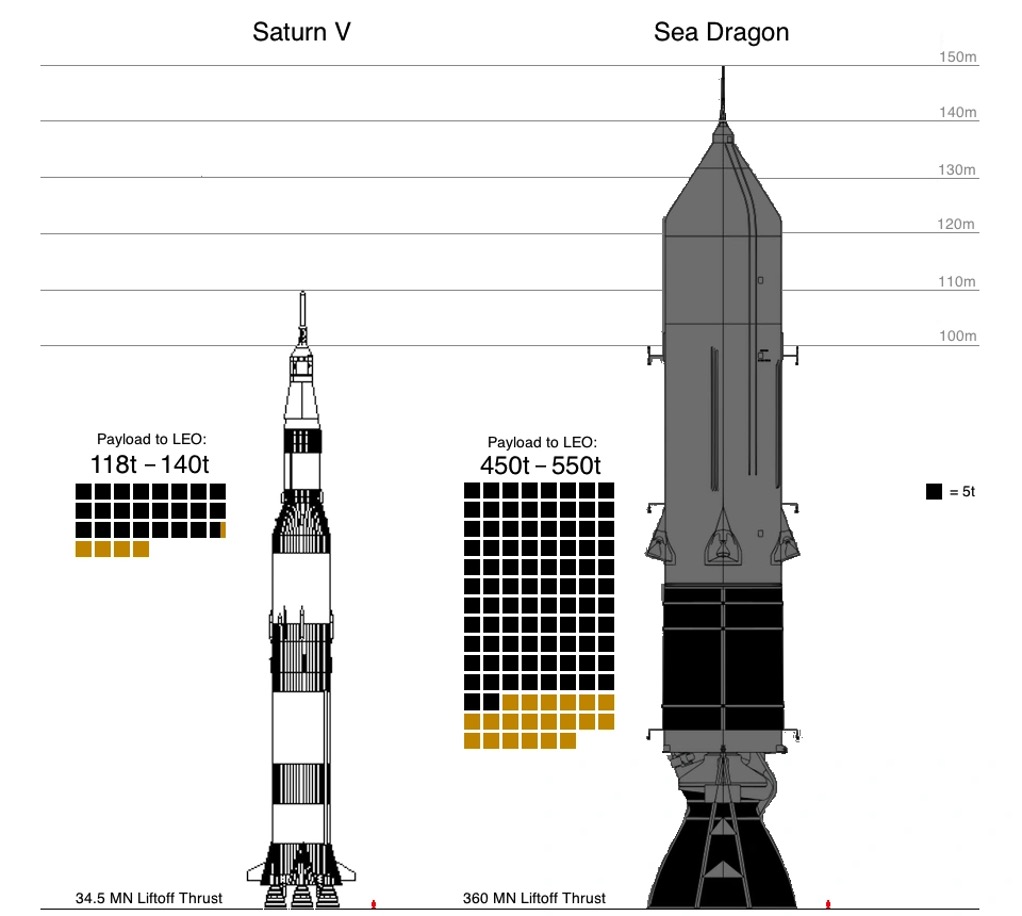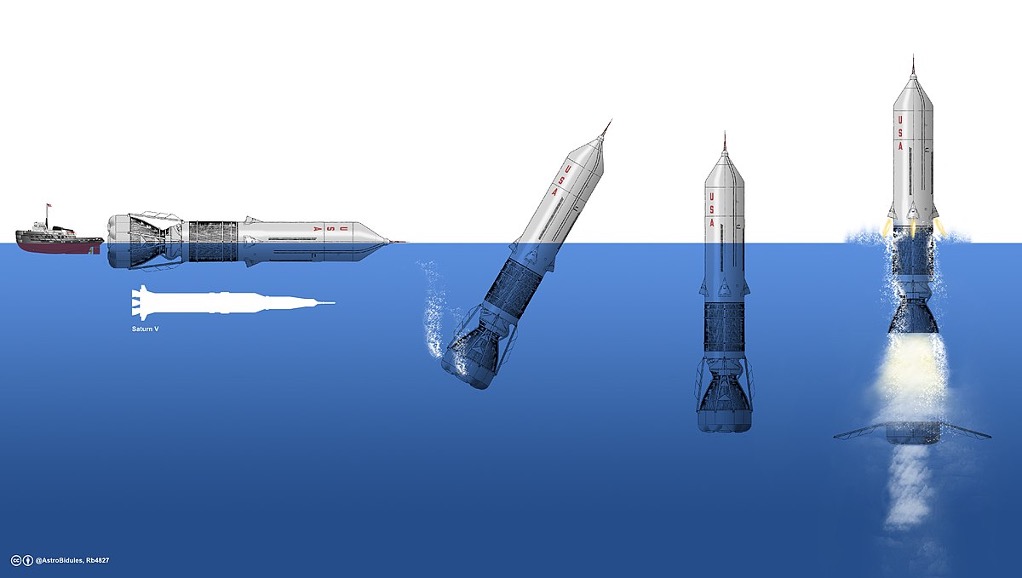#^Sea Launch: Is the Sea Dragon rocket real?In the early 60s, the Cold War was in full swing. NASA’s budget was almost unlimited. This gave rise to ambitious plans beyond landing on the Moon. NASA also considered building long-term bases on it and flying to Mars. To deliver the required amount of materials, the largest rocket ever made would be a necessity. Today we know that these plans were realised with the
Saturn V rocket. It was this launcher that delivered the Apollo spacecraft to the Moon six times. But did you know that things could have been different? After all, there was another project — Sea Dragon Rocket.
The first season finale of
For all Mankind tells an alternate history of space exploration. A giant rocket rises from the depths of the sea to deliver supplies to the Jamestown Moon Base. It looks truly impressive. But even more impressive is that this story is not complete fiction. NASA really considered creating a giant space monster that would launch from the water, not from the ground. Sea Dragon Rocket could become the largest space launch vehicle ever designed. Why was it abandoned, and was the idea of a sea launch eventually realized? Let’s find out!
The Sea Dragon: the birth of a legend
The Sea Dragon project was proposed in 1962 as an alternative to the Saturn V. The original idea came from talented Aerojet rocket engineer and retired US Navy Captain Robert Truax, who played a key role in the development of the Polaris submarine-launched ballistic missile, the U.S. Navy’s Viking sounding rocket, and the Thor ballistic missile.
Truax proposed to create the so-called Big Dumb Booster. The booster would be a very powerful yet affordable rocket. It had to be technologically simple because the increase in power would be achieved simply by increasing the launcher’s size. To give you an idea of how huge the Sea Dragon would have been, let’s compare it to the Saturn V.
Sea Dragon rocket vs Saturn V size comparison
And this is what a visual comparison looks like. Against the background of Sea Dragon, the 110-meter tall Saturn V looks like a tiny baby.

Saturn V and Sea Dragon rockets size and payload comparison
Sea Dragon would have been a two stage rocket. Each stage would have been equipped with only one very powerful engine (as opposed to five for Saturn V). A pressurized fuel injection system replaced the complex system of turbopumps. But the fuel components were supposed to be the same as those of the Saturn V — liquid oxygen and kerosene RP 1 for the first-stage engine and liquid hydrogen and oxygen for the second-stage engine.
Could Sea Dragon rocket have ever worked?
Launching such a giant from the ground would simply be impossible, so it had to be launched from the sea, literally right out of the seawater, which Truax considered a great advantage since there was no need for a launch platform.
A system of large ballast tanks would have been attached to the bottom of the first-stage engine to keep the rocket upright. In this position, the payload, located on top of the second stage, was slightly above the waterline, thus ensuring easy access to it.
After launch, the first-stage engine had to work for 80 seconds and lift the rocket to a height of about 40 km. After that, the second-stage engine would do its part, and Sea Dragon was supposed to go into orbit at the height of 230 km.
LEO on the cheap
To make the rocket manufacture as cheap as possible, Truax planned to build its body not from aluminum but from 8 mm steel sheets, which ultimately made the production no more difficult than building a submarine. Thanks to this, the carrier could be assembled at shipyards and then towed to the launch site directly on the water. The shipbuilding company Todd Shipyards was ready to take on the construction.

Sea dragon launch steps demonstration
The project’s engineers also suggested obtaining hydrogen and oxygen for fuel by electrolysis right before the launch. A nuclear powered aircraft carrier would provide power for this process.
Truax also insisted that the Sea Dragon rocket should be reusable. The first stage was to descend with the help of giant airbags about 300 km from the launch site. It would then undergo a recovery procedure for further reuse. However, most advocates believed that the best way to reduce costs was to build simple disposable equipment from inexpensive materials. US Air Force Lieutenant Colonel John London expounded on the idea in the book “LEO on the Cheap”, which has become something of a “Bible” for Big Dumb Booster supporters.
Eventually, however, the main problem in implementing Sea Dragon was not disagreements but a reassessment of the project’s economic efficiency.
How much did the Sea Dragon rocket cost?
Aerojet calculated that the total cost of designing the rocket was $2.836 billion (for 1962) and $300 million per launch. To convert this to today’s inflation-adjusted amounts, multiply the figure by 8. For comparison, the entire Apollo program, including mission support, cost the US budget $55 billion in today’s figures, and the cost of one launch was $1.4 billion.
Why was Sea Dragon never built?
The fact is that the profitability rates of the project were calculated taking into account 12-24 launches per year, which was impossible in practice. Saturn V, having a three times lower payload capacity, made only 13 launches in 7 years. That is why even twelve Sea Dragon launches per year looked too optimistic. The rocket’s payload capacity was so great that there simply would not be enough cargo for it to carry. The largest man-made space object that exists today, ISS, has a mass of 450 tons. That is, for Sea Dragon to be cost-effective, it needed to launch an ISS-sized payload at least 12 times a year. It looks unrealistic even today when NASA is planning to colonize the moon.
Besides, when the US government found out the cost of the Apollo program in 1964, it became obvious that there would be no budget for another large-scale project. If the U.S. government had given NASA the green light to send people to Mars after the Apollo program, the Sea Dragon rocket project could have been justified. But that never happened. However, NASA shut down Apollo in 1973 as unprofitable and of little scientific value. NASA buried the Big Dump Booster ideas as well.
What came instead of Sea Dragon?
Though the concept of the largest rocket ever had to be abandoned due to the complexity of its implementation and practical inexpedience, then the idea of launching a rocket from the sea was successfully implemented. Twice, even.
San Marco
In 1964, in the Indian Ocean off the coast of Kenya (Farmosa Bay), not far from the city of Malindi, the first ever floating spaceport, called San Marco (Italian Luigi Broglio Space Center), was put into operation. It consisted of two oil platforms, “San Marco” and “Santa Rita”, converted into a launch pad and MCC, and two logistics support vessels. That is, the consortium launched not from the water, as the Sea Dragon rocket project implied, but from a floating platform.
Researchers used San Marco to launch the American Scout vehicle from 1967 to 1988, then mothballed the site. However, the communication station on land helps to track the satellites of NASA, ESA, ASI, and others up to this day.
Sea Launch
In 1995, a four-nation consortium came together to create Sea Launch (Boeing-USA, the Russian rocket and space company Energia, the Norwegian shipyard Aker Solutions, and two Ukrainian rocket-building giants, namely Yuzhnoye Design Bureau and the Yuzhmash plant ). The last two provided their unique
Zenit 3SL rocket, specially modified for sea launches.
Sea Launch operated successfully for 19 years. During this time, Zenit 3SL made 36 launches, only three of which failed.
Elon Musk highly praised the Ukrainian rocket, calling it the best in the world after his Falcon 9.
Unfortunately, the annexation of Crimea and Russia’s invasion of the Donbas region in 2014 forced the Ukrainian side to stop participating in the project. The main owner of Sea Launch at that time, the Russian corporation S7, faced the problem of replacing the Ukrainian Zeniths — something it has not been able to resolve.
The subsequent escalation of the Ukrainian-Russian conflict in 2022 finally called into question not only the existence of Sea Launch, but also the entire space industry of the aggressor country. As for Ukraine, we hope that after this country’s victory, it will revive its rocket industry, and we will still see the unique
space developments of Ukrainian engineers. In the meantime, they are focusing their efforts on their domestic defense industry.
Final thoughts
The sad fate of Sea Launch is not the death knell of sea-borne launch. The growing number of launches is forcing China and other countries to consider expanding launch infrastructure at sea, and SpaceX is already using offshore platforms to land Falcon’s first stages with great success.
As for launchers like the Sea Dragon rocket are concerned, there is no need for such huge monsters today. Colonizing the Moon and Mars is the purview of other, much more modern and no less feasible heavy rockets launched from the ground. These are SLS, Starship, New Glenn, Neutron, and some others.
SLS already launched to the moon in November last year. Next up is Starship.
The post
Sea Launch: Is the Sea Dragon rocket real? appeared first on
Orbital Today.